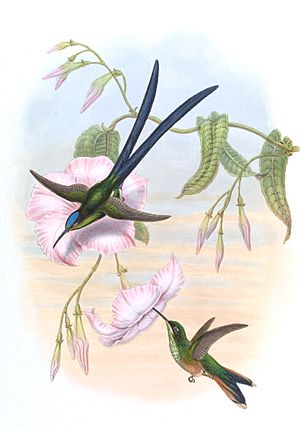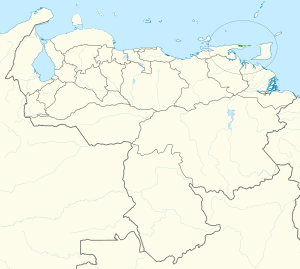Scissor-tailed hummingbird facts for kids
Quick facts for kids Scissor-tailed hummingbird |
|
|---|---|
 |
|
| Conservation status | |
| Scientific classification | |
| Genus: |
Hylonympha
|
| Species: |
macrocerca
|
 |
|
The scissor-tailed hummingbird (Hylonympha macrocerca) is a special type of hummingbird found only in Venezuela. It gets its name from the male's very long, forked tail, which looks a bit like open scissors. This beautiful bird is currently an Endangered species. This means it is at high risk of disappearing forever.
Contents
What is a Scissor-tailed Hummingbird?
The scissor-tailed hummingbird is the only species in its group, called Hylonympha. It does not have any different types or subspecies. Scientists have studied it for a long time. They decided it should stay in its own unique group.
How Does it Look?
Scissor-tailed hummingbirds are quite striking. The male is about 19 centimeters (7.5 inches) long. This measurement includes its amazing tail. The tail itself can be 9 to 10 centimeters (3.5 to 4 inches) long! Males weigh about 7 to 7.5 grams (0.25 to 0.26 ounces).
Females are a bit smaller. They are about 12 to 13 centimeters (4.7 to 5.1 inches) long. They weigh between 6.5 and 8 grams (0.23 to 0.28 ounces). Both males and females have a long, slightly curved black beak.
Male Hummingbirds
Male scissor-tailed hummingbirds have a bright violet forehead. The top of their head is a very dark green, almost black. Their back is a shiny grass green. Their neck has a golden glow.
Their throat and chest are a sparkling emerald green. The rest of their belly is a darker green, becoming blackish. The sides of their body have green spots. The most amazing part is their tail. The outer feathers are much longer and wider than the others. They are a blackish-purple color.
Female Hummingbirds
Female scissor-tailed hummingbirds look different from males. Their forehead and the top of their head are a dark, shiny green. Their throat and chest are white. They have green spots on their chest, but not in the very middle.
Their belly and the feathers under their tail are a reddish-brown color. Their tail is forked, but not as long or dramatic as the male's. The middle tail feathers are green at the base. They turn steel blue at the ends. The outer feathers are cinnamon colored with light beige tips.
Where Do They Live?
The scissor-tailed hummingbird lives only in a small area. This area is called the Paria Peninsula. It is located in the northeastern part of Venezuela.
These birds prefer to live inside damp, old subtropical forests. They also like cloudforests. Cloudforests are forests that are often covered in clouds or mist. You can also find them at the edges of forests. Sometimes they are seen in small clearings. They live at elevations from 500 to 1200 meters (1,640 to 3,940 feet) above sea level.
Daily Life and Behavior
Movement
Scissor-tailed hummingbirds do not travel far. They tend to stay in the same area their whole lives. This means they are not migratory birds.
What Do They Eat?
These hummingbirds mainly drink nectar from flowers. They especially like the flowers of bromeliad plants. They also get nectar from Heliconia and Costus flowers. Female hummingbirds might even protect their favorite feeding spots.
Besides nectar, they also eat small insects. They catch insects by picking them off plants. They also "hawk" for insects. This means they fly out from a perch to catch insects in the air.
Sounds They Make
The song of the scissor-tailed hummingbird is a short, pulsing sound. It is often described as "tsi-si-sip...tsi-si-sip..." or "tsi-sip...tsi-sip...tsi-sip...".
Why Are They Endangered?
The scissor-tailed hummingbird is an endangered species. This means its population is very small. It is at risk of becoming extinct. Experts estimate there are only about 3,000 to 4,000 adult birds left. Their numbers are still going down.
The main reason they are endangered is because their forest home is being cut down. People are clearing the forests for farming. These hummingbirds seem to need undisturbed cloudforests to survive.
Part of their home is inside the Península de Paria National Park. However, much of their habitat is outside the park. Even inside the park, the protection is not very strong. This makes it harder to save these unique birds.
See also
 In Spanish: Colibrí tijereta para niños
In Spanish: Colibrí tijereta para niños


